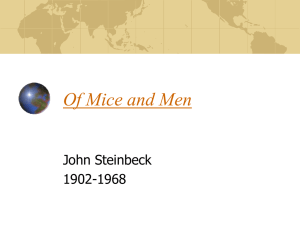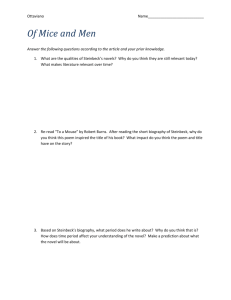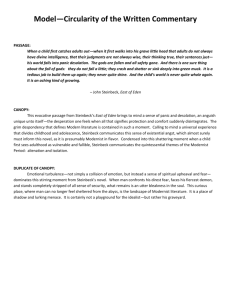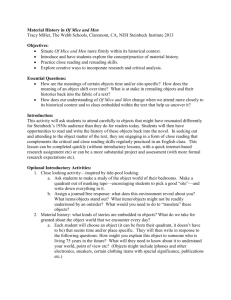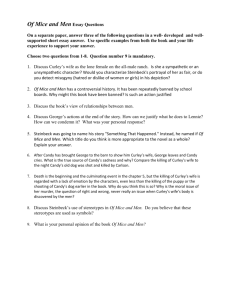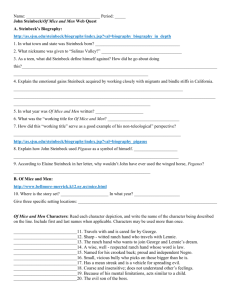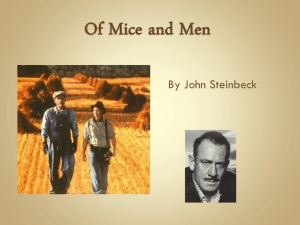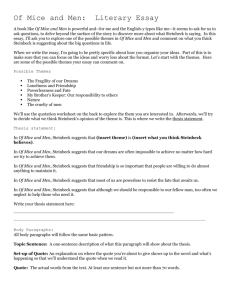Of Mice and Men by John Steinbeck
advertisement
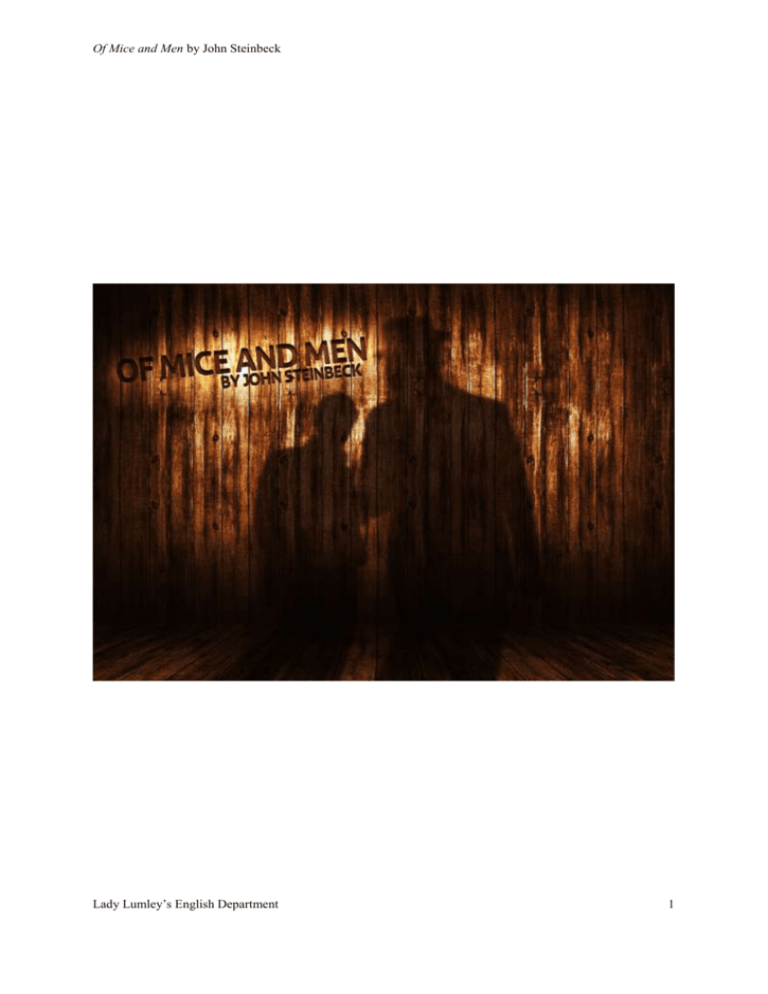
Of Mice and Men by John Steinbeck Lady Lumley’s English Department 1 Of Mice and Men by John Steinbeck Of Mice and Men by John Steinbeck Introduction This teaching pack is a creative and comprehensive resource that will complement every English teacher’s tool kit. Though prepared with the GCSE English Literature examinations in mind, also included are a range of activities that teachers can use and / or adapt for Controlled Assessment tasks. * The pack contains a number of reading, writing and speaking and listening activities and there is considerable opportunity for students to undertake individual, pair and group work. Many of the tasks and activities allow students to engage with the text in exciting and dynamic ways, whilst other tasks and activities take a more formal and traditional approach. Similarly, there is a balance of teacher and student-led tasks, and also a number of opportunities and suggestions for differentiation. In addition to a wide variety of worksheets, the pack also contains a number of useful ‘Keeping Track’ resources, which can be used throughout the unit. Alternatively, they can be used as a revision tool at the end of the unit. The variety of tasks and activities ensures that students are offered many creative opportunities and approaches in their study of the text, aiding perception of the author’s intentions as well as a thorough analysis of the context, themes, characters and literary techniques. This printable pack is supported by a comprehensive collection of audio files on the text.** Using the audio files Lady Lumley’s English Department 2 Of Mice and Men by John Steinbeck - Use them as starters / settling tasks as applicable / appropriate - Use for plenaries as applicable / appropriate - Find accompanying images to put into photo story / moviemaker / powerpoint - Use them as a guide for students who would like to script and record their own audio files - Revision activities - Annotating and note taking - Homework and research tasks Interactive whiteboard Also available within the collection are a range of themed interactive whiteboard tools together with a selection of interactive whiteboard resources with pre-loaded demo question sets / content. A number of question sets and content are also provided as text files for you to load into selected resources as applicable / appropriate to your students and classes.*** Resources have been created so that they can be used as teacher-led, whole class activities and / or used by students working independently. * Individual teachers should confirm the choice and title of controlled assessment tasks with the relevant awarding body. ** SPOILER ALERT. All of the audio files contain information that might spoil students’ enjoyment of the text. *** Indicates IWB resources where teachers / students can add their own content / question sets. CONTENTS – printable resources Resource 1: Introduction Lady Lumley’s English Department 3 Of Mice and Men by John Steinbeck Resource 2: Contents Resource 3: Assessment Objectives - WJEC Resource 4: Assessment Objectives - AQA Resource 5: Context: the importance of understanding context Resource 6: Context: The Great Gatsby and 1920s America Resource 7: Context: a timeline Resource 8: Context: John Steinbeck Resource 9: Pre-reading prediction activities: book covers Resource 10: Pre-reading prediction activities: friends (George and Lennie) Resource 11: Style: setting the scene - the Salinas River Resource 12: Style: setting the scene - the bunk house. Context: ranch life and migrant workers Resource 13: Grabbing the reader: novel openings and Steinbeck’s techniques Resource 14: Style: dialect Resource 15: Context: The American Dream Resource 16: Character: Curley Resource 17: Context: research task on the role of women Resource 18: Character: Curley’s wife - initial impressions Resource 19: Character: Curley’s wife - the end of the novel Resource 20: Character: Casting Curley and Curley’s wife Resource 21: Context and theme: research and presentation on disability Resource 22: Context: race and prejudice Resource 23: Character: Crooks Resource 24: Context: ranch life and social hierarchy Resource 25: Style: narrative point of view and play-like features Resource 26: Style: structure and plot Resource 27: Style: foreshadowing Resource 28: Style: the ending Resource 29: Character: George - debating the ending Resource 30: Context: censorship Lady Lumley’s English Department 4 Of Mice and Men by John Steinbeck Resource 31: Title Resource 32: Theme tree Resource 33: Themes: dreams and the American Dream Resource 34: Themes: loneliness and companionship Resource 35: Keeping track: quotations chapters one to six Resource 36: Keeping track: character CONTENTS - audio files Lady Lumley’s English Department 5 Of Mice and Men by John Steinbeck Audio file 1: Chapter one - summary Audio file 2: Chapter two - summary Audio file 3: Chapter three - summary Audio file 4: Chapter four - summary Audio file 5: Chapter five - summary Audio file 6: Chapter six - summary Audio file 7: George Audio file 8: Lennie Audio file 9: Curley’s wife Audio file 10: Curley Audio file 11: Candy Audio file 12: Crooks Audio file 13: Animals, imagery and symbolism Audio file 14: Setting Audio file 15: Dialect Audio file 16: Disability Audio file 17: Race Audio file 18: Women Audio file 19: Dreams and The American Dream Audio file 20: The Great Depression CONTENTS – IWB tools and resources Lady Lumley’s English Department 6 Of Mice and Men by John Steinbeck IWB 1: A themed timer IWB 2: Image analysis template *** IWB 3: Single spinner *** IWB 4: Double spinner *** IWB 5: Ranking / grouping / sequencing / sorting template *** IWB 6: Dream quiz *** IWB 7: Dream quiz question editor IWB 8: Activity spinner *** IWB 9: Activity spinner editor IWB 10: Stop the clock *** IWB 11: Stop the clock question editor IWB 12: Text analysis template *** IWB 13: Slim’s spin quiz *** IWB 14: Curley’s ‘Who said that?’ quiz *** IWB 28: Curley’s quiz editor instructions *** Indicates IWB resources where teachers / students can add their own content / question sets. WJEC English Literature 2010 Lady Lumley’s English Department 7 Of Mice and Men by John Steinbeck Unit 1, Section A: Prose (different cultures) Of Mice and Men by John Steinbeck Assessment Objectives AO1 Respond to texts critically and imaginatively; select and evaluate relevant textual detail to illustrate and support interpretations AO2 Explain how language, structure and form contribute to writers’ presentation of ideas, themes and settings AO3 Make comparisons and explain links between texts, evaluating writers’ different ways of expressing meaning and achieving effects AO4 Relate texts to their social, cultural and historical contexts; explain how texts have been influential and significant to self and other readers in different contexts and at different times Things you need to know (WJEC) Lady Lumley’s English Department 8 Of Mice and Men by John Steinbeck - This unit will be externally examined. - You have to answer two questions on the play. - Part (a) is based on a short extract and will be marked out of ten using AO1 and AO2. - For part (b) OR part (c) you will have to write an essay on the novella. - You will have a choice of two essay titles. Your essay will be marked out of twenty using AO1 and AO4. - You are NOT allowed to take copies of the play into the examination. - You will have one hour to complete both of your answers on Of Mice and Men. (Don’t forget, this is just one section of a two-hour exam.) - You should spend about 20 minutes on part (a) and about 40 minutes on part (b) OR part (c). - A notional indication of how the marks are allocated across the Assessment Objectives can be found in the table below. In practice, however, examiners will give an overall mark based on appropriate coverage of each Assessment Objective. WJEC Question Mark / AO1 AO2 a) / 10 5 5 b) OR c) / 20 7 AO3 AO4 Unit 1, Section A Lady Lumley’s English Department 13 9 Of Mice and Men by John Steinbeck Unit 1, Section B: Exploring Cultures Of Mice and Men by John Steinbeck Assessment Objectives AO1 Respond to texts critically and imaginatively; select and evaluate relevant textual detail to illustrate and support interpretations AO2 Explain how language, structure and form contribute to writers’ presentation of ideas, themes and settings AO3 Make comparisons and explain links between texts, evaluating writers’ different ways of expressing meaning and achieving effects AO4 Relate texts to their social, cultural and historical contexts; explain how texts have been influential and significant to self and other readers in different contexts and at different times Lady Lumley’s English Department 10 Of Mice and Men by John Steinbeck Things you need to know (AQA) - This unit will be externally examined. - You have to answer one question on the novella but the question will be in two parts. - Part (a) is based on a short extract. - For part (b) you will have to write an essay where you link the extract to the novella as a whole. - Your answers to part (a) and part (b) will be marked out of thirty using AO1, AO2 and AO4. - You ARE allowed to take a copy of the book into the examination but your copy MUST NOT be annotated, and MUST NOT include any other notes or materials. - You will have 45 minutes to complete your examination on Of Mice and Men. (Don’t forget, this is just one section of an exam that lasts one hour, thirty minutes.) - A notional indication of how the marks are allocated across the Assessment Objectives can be found in the table below. AQA Question Mark / AO1 AO2 Unit 1 Section B / 30 11.25 11.25 Lady Lumley’s English Department AO3 AO4 7.5 11 Of Mice and Men by John Steinbeck Social, Historical and Cultural Context in Of Why is context important? Mice and Men by John Steinbeck It is important to study the period, both in time and place, in which A large percentage of this unit on the new specifications will assess texts are written in order to fully understand and appreciate them. In your knowledge and understanding of the social, historical and addition to the author’s personal views and beliefs, many events and cultural context of the novella. attitudes from the period will have influenced the content, plot and For WJEC students, approximately 13 out of 20 of your marks themes of the novella. So, to fully understand Of Mice and Men you will link to this assessment objective. will need to understand what happened in America between 1900 For AQA students, approximately 7 out of 30 of your marks and 1940. will link to this assessment objective. Social, Historical and Cultural Context social issues MORALS AND ETHICS TASK key events culture the literary background work and (un)employment class and status the author’s background politics HISTORY poverty and wealth HEALTH AND WELFARE Lady Lumley’s English Department family gender To show the importance of context, read the following newspaper article. You will all understand most of the references within the piece. However, imagine that this article is sent to that proverbial old hermit who lives in a cave in Outer Mongolia. (If you don’t understand this saying about ‘Outer Mongolia’, ask your teacher to explain the context.) Highlight every reference that our hermit would need to research in order to fully understand the article. Of Mice and Men by John Steinbeck Facebook fans do worse in exams Research finds the website is damaging students’ academic performance FACEBOOK users may feel socially successful in cyberspace but they are more likely to perform poorly in exams, according to new research into the academic impact of the social networking website. They found that 65% of Facebook users accessed their account daily, usually checking it several times to see if they had received new messages. The amount of time spent on Facebook at each log-in varied from just a few minutes to more than an hour. The Ohio report The shows that students who used Facebook had a “significantly” lower grade point average - the marking system used in US universities - than those who did not use the site. Daisy Jones feared the time she spent on Facebook was threatening her studies, so she deactivated her account The majority of students who use Facebook every day are underachieving by as much as an entire grade compared with those who shun the site. Researchers have discovered how students who spend their time accumulating friends, chatting and “poking” others on the site may devote as little as one hour a week to their academic work. The findings will confirm the worst fears of parents and teachers. They follow the ban on social networking websites in many offices, imposed to prevent workers from wasting time. About 83% of British 16 to 24-year-olds are thought to use social networking sites such as Facebook, MySpace and Bebo, to keep in touch with friends and organise their social lives. “Our study shows people who spend more time on Facebook spend less time studying,” said Aryn Karpinski, a researcher in the education department at Ohio State University. “Every generation has its distractions, but I think Facebook is a unique phenomenon.” Karpinski and a colleague questioned 219 US undergraduates and graduates about their study practices and general Internet use, as well as their specific use of Facebook. Lady Lumley’s English Department “It is the equivalent of the difference between getting an A and a B,” said Karpinski, who will present her findings this week to the annual meeting of the American Educational Research Association. She has not yet analysed whether a student’s grades continue to deteriorate the longer he or she spends on Facebook. Some UK students have already spotted the potential danger. Daisy Jones, 21, an undergraduate in her final year at Loughborough University, realised the time she was spending on Facebook was threatening her grades - prompting her to deactivate her account. “I was in the library trying to write a 2,000-word essay when I realised my Facebook habit had got out of hand,” she said. “I couldn’t resist going online. You do that, then someone’s photo catches your eye. Before you know it, a couple of minutes has turned into a couple of hours and you haven’t written a thing.” Jones is among the few to have recognised the risks. According to Karpinski’s research, 79% of Facebookusing students believed the time they spent on the site had no impact on their work. Facebook said: “There is also academic research that shows the benefits of services like Facebook. It’s in the hands of students, in consultation with their parents, to decide how to spend their time.” Jonathan Leake and Georgia Warren From The Sunday Times April 12, 2009 Of Mice and Men by John Steinbeck Researching Context Though not all of them will be necessary / applicable to every text, there are a wide range of sources that you can use to help you in your research of the social, historical and cultural context of a text. Select one of the following sources and use it to find five facts relating to the context of Steinbeck’s Of Mice and Men. diaries and eyewitness accounts museums LIBRARY newspapers art and paintings tv documentaries and programmes other fiction news reports radio reports postcards encyclopedias music law and laws history books national archives fashion and period clothing Lady Lumley’s English Department census data antiques general register office memorabilia and artefacts film and film archives journals PHOTOGRAPHS scholarly collections internet POSTERS AND ADVERTS Of Mice and Men by John Steinbeck Context An introduction to 1920s America SOCIAL, HISTORICAL AND CULTURAL CONTEXT. ___________________________________________________________________________ Music Follow the link below to listen to clips of music by THE ORIGINAL MEMPHIS FIVE. Lady Lumley’s English Department Of Mice and Men by John Steinbeck http://www.tradebit.com/filedetail.php/50668849-the-original-memphis-five Read this extract from The Great Gatsby by F. Scott Fitzgerald. It was first published in 1925, twelve years before Steinbeck’s Of Mice and Men. The novel is set in New York during the Roaring Twenties. …The bar is in full swing, and floating rounds of cocktails permeate the garden outside, until the air is alive with chatter and laughter, and casual innuendo and introductions forgotten on the spot, and enthusiastic meetings between women who never knew each other's names. The lights grow brighter as the earth lurches away from the sun, and now the orchestra is playing yellow cocktail music, and the opera of voices pitches a key lighter. Laughter is easier minute by minute, spilled with prodigality, tipped out at a cheerful word. The groups change more swiftly, swell with new arrivals, dissolve and form in the same breath; already there are wanderers, confident girls who weave here and there among the stouter and more stable, become for a sharp, joyous moment the centre of a group, and then, excited with triumph, glide on through the seachange of faces and voices with colour under the constantly changing light. Suddenly one of these gypsies, in trembling opal, seizes a cocktail out of the air, dumps it down for courage and, moving her hands like Frisco, dances out alone on the canvas platform. A momentary hush; the orchestra leader varies his rhythm obligingly for her, and there is a burst of chatter as the erroneous news goes around that she is Gilda Gray's understudy from the Follies. The party has begun. Lady Lumley’s English Department Of Mice and Men by John Steinbeck Click the snapshot below, or enter the web address provided, to watch a video portraying life in the 1920s. Link: http://www.youtube.com/watch?v=684n8FO68LU The Roaring Twenties What were the ‘Roaring Twenties’ like? Highlight sections from the extract that you feel capture the spirit and mood of 1920s America and make a note of your ideas alongside the highlighted sections. Look at the following first edition book cover for Fitzgerald’s The Great Gatsby. Use this to make predictions about the setting, plot, characters and Lady Lumley’s English Department Of Mice and Men by John Steinbeck themes in the novel and add to your list of ideas about the ‘Roaring Twenties’. John Steinbeck John Steinbeck was born in Salinas, California in 1902 where he grew up in a fertile agricultural valley (known as ‘America’s Salad Bowl’) about twenty-five miles from the Pacific Coast. Many of his powerful novels such as, Of Mice and Men, The Grapes of Wrath and East of Eden’have all been inspired by the Californian landscape and the history of the land. Steinbeck's novels can all be classified as social novels dealing with the economic problems of rural labour. They tend to focus on trials and tribulations people experience and often make the reader root for the underdog. Since Steinbeck grew up in California, he would have witnessed the aspirations of migrant workers, along with the mistreatment they suffered. In 1962, Steinbeck won the Nobel Prize for literature for his “realistic and imaginative writing, combining as it does sympathetic humor and keen social perception.” Both The Grapes of Wrath and Of Mice and Men won Pulitzer Prizes. They both focused on the plights of poor migrant workers searching for hope and the American Dream. In pairs, discuss what you think John Steinbeck means by this quote: “The writer is delegated to declare and to celebrate man's proven capacity for greatness of heart and spirit - for gallantry in defeat, for courage, compassion and love. I hold that a writer who does not believe in the perfectibility of man has no dedication nor any membership in literature.” Lady Lumley’s English Department Of Mice and Men by John Steinbeck Context DATE DESCRIPTION Californian Gold Rush: discovery of gold in California sparks a major wave of 1848 migration from the east of the USA (and Europe) to California on the west coast. One of the towns created as a result of the Gold Rush was Auburn. Period of mass immigration into the USA from abroad (c.40 million people), especially from Europe. People came for many reasons but in particular to 1850-1914 escape poverty and/or political oppression. America was seen as ‘the home of the free’ and a land of opportunity where hard work will bring success. Many dreamt of owning and farming their own land. 9.9.1850 California is declared to be the 31st state in the United States of America Pacific Railway Act opens the way for the building of the Transcontinental 1862 Railway, connecting the east and west Coasts via the interior and providing relatively rapid and cheap transport for goods and people across the United States The emancipation (freeing) of the slaves and the abolition of slavery following the American Civil War (1863-1865). Many freed slaves moved from the 1865 southern states to the northern cities but some went west where they became ‘sharecroppers’: farmers who were allowed to farm part of someone else’s land in return for paying a share of their crops to the landowner. February 27th: John Steinbeck born in Salinas, California. This was an intensive agricultural (farming) area of California with Salinas and Soledad both being important towns. By 1902 there was a large sugar beet industry and after the First World War the expansion of irrigation projects (bringing 1902 water to the land rather than just relying on rainfall and existing rivers) meant that during the 1920s the area of the Salinas Valley became the ‘salad bowl’ of America, with lettuce (Green Gold), broccoli and artichokes forming the major crops. These crops provided jobs for a large number of temporary workers. However, there are still ranches growing wheat, cattle and sheep with which Steinbeck would be familiar. Lady Lumley’s English Department Of Mice and Men by John Steinbeck The First World War: America entered the war in 1917 with over 2 million men going to fight in Europe (although many arrived too late to see much, if any, actual fighting). Troops returning to the USA brought back German army 1914-1918 Luger pistols as prize souvenirs. The war was beneficial for American agriculture and industry as they exported food, industrial goods and munitions to Europe. Russian Revolution – raises fears of communism in the USA (communism = the violent overthrow of the upper classes by the working class). Marcus Garvey starts the first branch of The Universal Negro Improvement and Conservation Association (UNIA) in the United States. This is an 1917 organisation devoted to improving the status of black people. It is one of a number of such organisations including the National Association for the Advancement of Coloured People (NAACP) which was founded in 1909. Racial segregation (black people being prevented from mixing with white people in public places such as schools, hospitals and parks) was enforced by laws in many states. Such laws are often referred to as ‘Jim Crow’ laws. Prohibition starts in the USA – the sale and consumption of alcoholic drinks (all drinks more than 5% proof) is banned throughout the United States of America. There are race riots against black people in 23 cities across the USA. 1919 The government cracks down on those suspected of being Communists (or ‘un-American’) – especially trades unionists and immigrants from countries thought to have links to communism. Strikes are put down by the government which does not see them as concerned with poverty and employment but as a threat to the American way of life. Lady Lumley’s English Department Of Mice and Men by John Steinbeck The Roaring Twenties / the Jazz Age: For many people in America (especially the cities such as New York and Chicago) the 1920s are years of considerable prosperity. American goods are protected from competition with imports by high tariffs (customs duties) and Americans are encouraged to buy American produced consumer products such as cars, washing machines, refrigerators and radios. Henry Ford pioneers the use of the ‘production line’ in his car factories and by 1928 him ‘Model T’ Ford costs only $295, down from $1200 in 1909, and he has sold over 15 million of them. The increase in car ownership leads to an increase in road building, bringing with it an increase in the number of trucks and buses. It becomes much easier to borrow money to purchase goods, for example through the new ‘hire-purchase’ schemes– getting the goods immediately but paying for them by instalments. People also borrow money to buy shares in American companies. By 1929 it is possible to borrow 90% of the money needed to buy shares: the idea is that the share price goes up, the owner then sells and pays back the money borrowed to buy the shares out of the money he gets on sale. This only works if the share price continues to rise. However, the ‘consumer boom’ meant that the profits of American companies rise dramatically and therefore so do the value of their shares. Share prices also go up because more and more people want to buy them. This is also the decade when the entertainment industry really takes off, particularly the movies, but also music (especially jazz). Hollywood becomes the centre of the movie production industry and the ‘movie star’ is born, their fame spread by the increasing numbers of tabloid newspapers and magazines. Stars such as Rudolf Valentino and Clara Bow (the first ‘It’ girl) become household names. By 1930 100 million tickets to the movies are sold in America every week. As jazz and swing become the rage dances become more energetic: this is the era of the Charleston and the Black Bottom Stomp. Lady Lumley’s English Department Of Mice and Men by John Steinbeck Women start to play a growing role in the American economy, both as consumers and workers. Between 1920 and 1929 the number of working women over the age of 15 increases by 50% to c.10 million (25% of the female population over 15). However, women’s wages are usually considerably lower than those of men, even where they were doing the same or similar jobs. Women are subject to criticism for the way they dress and act as skirts and hair get shorter, cosmetics got cheaper and women become more economically independent. Women drive and smoke. Fashionable clothes become cheaper and easier to obtain with a massive increase in chain stores throughout the USA. The consumer goods boom does not affect all people equally. By 1929 over 50% of Americans earn less than $2000 a year, with 40% below the poverty line. Black and immigrant workers are particularly likely to be affected by low wages and unemployment. Farming families are far less likely to enjoy the consumer boom as many rural areas still have no electricity and small farm incomes drop dramatically as the price of wheat falls. In 1920 wheat costs $183 a bushel (a measure of wheat). By 1929 it is 38¢. a bushel. By 1929 farm incomes are roughly 40% of the national average. During the boom times of the 1920s c.1 million black farm workers lose their jobs. However, in California, which has a more industrialised form of farming with less small farms, farmers do better. Women are given the vote. 1920 The ACLU (American Civil Liberties Union) is founded: they fight for civil rights such as freedom of speech and the right to belong to trades unions. America’s first radio station, KSKA, is started. Warren G. Harding (Republican) succeeds Woodrow Wilson (Democrat) as President. Wilson had believed in ‘active’ government. That is that the government should take an active part in promoting the welfare of its people. Republicans believed that the government should interfere in people’s lives 1921 as little as possible. The Immigration Quota Act imposes a quota system on the number of new immigrants coming to the USA. UNIA has a membership of more than 1 million. Fordney-McCumber Act introduces high tariffs (customs duties) on goods 1922 imported into the USA. This made American manufactured goods and agricultural produce cheaper than those manufactured / grown outside the USA and protected them against competition. Lady Lumley’s English Department Of Mice and Men by John Steinbeck Calvin Coolidge (Republican) become President following the death in office of Harding. Coolidge believes strongly that the government should interfere as little as possible in the lives of Americans. The Cotton Club opens in Harlem, New York. Harlem was an area of New York where many black people lived and all the entertainers were black: but 1923 only white customers were allowed in. Many famous black entertainers took to the stage at the Cotton Club, including Duke Ellington, Cab Calloway and Lena Horne. In the 1930s NBC broadcast radio shows from the Cotton Club twice a week. The Marathon Dance craze starts: competitions were held to see which couple could dance the longest. In the 1930s these became seen as a way out of poverty with couples being increasingly exploited by the promoters. The National Origins Act increases restrictions on immigration into the USA, favouring European immigrants. 1924 Salinas is the wealthiest per capita (i.e. per person) city in America, based on the lettuce crop which is sent all over the USA using refrigerated rail transport. The Klu Klux Klan, an organisation dedicated to fighting for WASP (white, anglo-saxon, protestant) supremacy claims to have 5 million members, some of whom held high political office in southern states such as Alabama. It is anti-black, anti-Jewish, anti-Communist, anti-foreigner and was involved in incidents such as lynchings (execution of alleged rapists / murderers by a mob, without a trial) in the southern States. However, its popularity and membership start to decline from this point. July: John Scopes, a teacher in Tennessee, is tried for teaching Charles 1925 Darwin’s theory of evolution. Tennessee was one of a number of states in the Bible Belt (in the south and mid-west) which banned the teaching of evolution as being contrary to the biblical history of creation set out in the Book of Genesis. This becomes known as ‘the Monkey Trial’. It is the first trial in America to be broadcast on radio (in 2010 Britain still does not broadcast trials on radio or TV). Scopes was found guilty and fined $100. This was part of a wider backlash against what was seen as the immorality of the 1920s. Many such states tried to restrict people’s behaviour in public e.g. by banning ‘indecent’ swimming costumes. Lady Lumley’s English Department Of Mice and Men by John Steinbeck Carl Eric Wickman forms the bus company which will become known as the Greyhound Corporation. By 1939 the Company will provide over 200 million 1926 miles of travel annually, with 4,750 bus stations and nearly 10,000 employees. Death of Rudolf Valentino, one of the great stars of the silent movies. 1927 The Jazz Singer is the first ‘talkie’. 1928 Walt Disney produces Mickey Mouse. Herbert Hoover (Republican) becomes President. Hoover is a self-made man who rose from poverty to wealth. He believes strongly that people must take responsibility for their own lives and should not rely on the Government for support. Immigration restricted to only 150,000 a year with most places reserved for 1929 northern and western Europeans. 14th February 1929: The St. Valentine’s Day massacre in Chicago – members of the North Side Gang are murdered, probably on Al Capone’s orders. 16th May 1929: the first American Academy of Motion Pictures’ Awards ceremony takes place. These are called ‘the Oscars’ by 1939 but no one really knows why. Lady Lumley’s English Department Of Mice and Men by John Steinbeck The Wall Street Crash (Saturday 19th October – massive profit taking (selling shares at a high price to get the maximum amount of profit), leading to fall in share prices and more panic selling on Sunday 20th as people start to worry they will lose money. Those who can afford it buy shares as the price drops (often borrowing money to do so) and this means prices rise on Monday / Tuesday as demand grows again. Wednesday 23rd – again there is mass selling at the very end of the day (shares are only bought and sold during defined period of hours) followed by panic on Thursday 24th – everyone trying to sell but there are no buyers. To try and stop the panic the banks try to support the share market by using 29.10.1929 their money (i.e. the money belonging to their customers) to buy shares and keep the price up on Friday 25th. Monday 28th: more massive selling again and the banks don’t step in to buy. This continues on 29th but there are no buyers so prices fall and then fall further AND the buying / selling technology collapses preventing many even trying to sell shares which are now worthless. This leaves many speculators (those who bought hoping to make a quick profit) ruined as they borrowed money to buy shares expecting them to rise in value. The shares are worth nothing and they can’t repay what they borrowed. The banks that lent them the money can’t get it back and start to go broke. Many American companies are now worthless. Lady Lumley’s English Department Of Mice and Men by John Steinbeck The 1930s: the Great Depression Following on from the Wall Street crash, but not entirely caused by it, there is a major economic depression in America and elsewhere. The 1930s are years of mass unemployment, particularly in agriculture (with small farmers suffering particularly badly and losing their land when they are unable to repay the money they borrowed to buy it) and the traditional ‘heavy’ industries of coal, iron and steel. Many businesses, including several thousand banks, go bust. There is a cycle of depression: as one company goes bust and its workers become unemployed, it causes other businesses that relied on that company or its workers for its income - to go bust. When banks go bust those who have deposited their savings in that bank lose them. This starts another cycle as savers in other banks try to withdraw their savings, causing those banks to collapse. There is nothing like unemployment benefit or housing benefit, and no free national health system (some people had private health insurance, which increased during the 1930s). If you lose your job, you often lose your home and the whole family ends up on the streets. Many such families end up in living in cardboard shantytowns which become known as ‘Hoovervilles’. During the 1930s more women enter the workforce: but that is because they are much cheaper than men, with their average wage being 50% that of the average male wage. As an antidote to the depression popular entertainment, especially the movies, continues to grow. Going to the movies provides people with a short period when they could forget their troubles. The Hawley-Smoot Act is passed raising tariffs (customs duties) on imported goods to an all time high. Other countries react by imposing similar duties on American goods, including imports of American wheat, which had been a major export for America during the First World War and the early 1920s. The surplus wheat can’t be sold at home because the depression means that many people are struggling even to buy food. This helps to produce a major 1930 depression in farming as surplus wheat stocks build up and prices drop dramatically. Small farmers and ‘sharecroppers’ are hardest hit. Tenant farmers can’t pay their rent and farmers who bought land can’t pay back the loans they took out to buy it. They are evicted. This is the first of the drought years in the south and mid-west of the USA, adding to farmers’ problems. Lady Lumley’s English Department Of Mice and Men by John Steinbeck Al Capone, probably the most famous Prohibition gangster, who wielded 1931 considerable political power in Chicago, is finally jailed. Not for smuggling alcohol, or for murdering his rivals, but for not paying his taxes! In 1932 20% of small farmers lost their farms as a result of being unable to repay their loans because of the decrease in prices for agricultural goods. 1932 The ‘Hobo’ becomes a figure of American legend: in 1932 about 2 million unemployed, including farmers who have lost their land, are travelling the railroads looking for work. January: Franklin Delano Roosevelt (FDR) is sworn in as the 32 nd President. FDR is a Democrat who believes that the government should interfere in people’s lives to relieve poverty and stimulate employment. FDR introduces ‘The New Deal’ to try to get American agriculture and industry back on its feet. This includes providing food and clothing, schools and employment for the unemployed. Some work is provided through construction of roads, public buildings such as schools and hospitals and other improvement schemes. The Agricultural Adjustment Act: farmers who own their own land are paid to 1933 destroy crops and animals to try to raise agricultural prices. Famously the government paid for 6 million piglets which are then killed with some meat going to provide free food for the unemployed. However, payments are only made to landowners so many ‘sharecroppers’ and tenant farmers lose their livelihoods and head for the cities to swell the ranks of the unemployed there. December: Prohibition is ended. It hadn’t worked! Organised crime had made a fortune through smuggling liquor in from Canada and running ‘speakeasies, while many people set up their own ‘stills’ to brew illegal alcohol (and many suffered serious illness, including blindness, when this went wrong). As organised crime increased so did gang warfare. It did give us Elliot Ness and the Untouchables, though. Following a long period of drought (exceptionally dry weather) the mid-West (especially Oklahoma and Arkansas) are hit by dust clouds as the thin, dry 1934 soil is blown away: these areas become known as ‘The Dust Bowl’. Many farmers are forced to abandon their land, with approximately 350,000 – 400,000 passing over the Rocky Mountain ranges to the west, especially California, to seek work there. Lady Lumley’s English Department Of Mice and Men by John Steinbeck FDR’s government provides more help to the unemployed, American industry and agriculture, including providing loans to sharecroppers and tenant farmers to help them buy their land, and labour camps for migrant farm workers. 1935 - 37 In 1936 Americans get the right to join trades unions and join together to bargain for higher wages. 1936 is also the year of the Salinas lettuce strike, causing lettuce prices to rise over the whole of the USA. Salinas supplies 90% of the country’s lettuces. Of Mice and Men is published. Steinbeck finished writing it in 1936, just 1937 before the lettuce strike. Set near Soledad in the Salinas Valley where Steinbeck was born. Steinbeck publishes The Grapes of Wrath. In this book he deals with migrants from the Dust Bowl who go to work in the vineyards of California. He also describes ‘Hoovervilles’. 1939 The Second World War starts in Europe but America does not enter the War until 1941, when Pearl Harbour is bombed by the Japanese and then Hitler declares war on America. Lady Lumley’s English Department Of Mice and Men by John Steinbeck Book covers and posters FOCUS Pre-reading prediction activities. To analyse a range of the book and film covers / posters for Of Mice and Men and to use these to make predictions about the novella. Task Look at the following book covers and posters for John Steinbeck’s Of Mice and Men. Use one or more of them to make predictions about: setting plot characters themes Working on your own, make a note of your ideas. In pairs or small groups, discuss your observations. Share your ideas with your teacher and the rest of the class. Lady Lumley’s English Department Of Mice and Men by John Steinbeck Lady Lumley’s English Department Of Mice and Men by John Steinbeck Friends Read the conversation below and then, in pairs, rehearse a performance of the dialogue. Before you start rehearsing, consider the questions on the next page. PERSON 1: When I think of the swell time I could have without you, I go nuts. I never get no peace. PERSON 2: You want I should go away and leave you alone? PERSON 1: Where the hell could you go? PERSON 2: Well I could. I could go off in the hills there. Some place I’d find a cave. PERSON 1: Yeah? How’d you eat. You ain’t got sense enough to find nothing to eat. I’d find things. I don’t need no nice food with ketchup. I’d lay out in the sun PERSON 2: and nobody’d hurt me. An’ if I foun’ a mouse, I could keep it. Nobody’d take it away from me. PERSON 1: PERSON 2: PERSON 1: I been mean, ain’t I? If you don’t want me I can go off in the hills an’ find a cave. I can go away any time. No – look! I was jus’ foolin’. ’Cause I want you to stay with me. Lady Lumley’s English Department Of Mice and Men by John Steinbeck Friends Friendship is one of the main themes in John Steinbeck’s Of Mice and Men and the complex nature of the theme can be seen in this short extract of dialogue which has been taken from the opening chapter of the novella. What can you work out about the friendship and relationship between these two characters? *Explain your ideas and predictions.* What are your impressions of person one? Make a list of as many words as you can. ___________________________________________________________________ ___________________________________________________________________ ___________________________________________________________________ ___________________________________________________________________ What are your impressions of person two? Make a list of as many words as you can. ___________________________________________________________________ ___________________________________________________________________ ___________________________________________________________________ ___________________________________________________________________ What is the connection between these two men? Why are they together? ___________________________________________________________________ ___________________________________________________________________ ___________________________________________________________________ ___________________________________________________________________ Which of the men is the cleverest? ___________________________________________________________________ ___________________________________________________________________ ___________________________________________________________________ ___________________________________________________________________ Lady Lumley’s English Department Of Mice and Men by John Steinbeck Which of the men is in charge? ___________________________________________________________________ ___________________________________________________________________ ___________________________________________________________________ ___________________________________________________________________ Which of the men depends on the other? ___________________________________________________________________ ___________________________________________________________________ ___________________________________________________________________ ___________________________________________________________________ What do you notice about the balance of power and control in the relationship? ___________________________________________________________________ ___________________________________________________________________ ___________________________________________________________________ ___________________________________________________________________ Can we learn anything about the men from the way that they talk? ___________________________________________________________________ ___________________________________________________________________ ___________________________________________________________________ ___________________________________________________________________ Where do you think they are and where might they be going? ___________________________________________________________________ ___________________________________________________________________ ___________________________________________________________________ ___________________________________________________________________ In addition to the theme of friendship, what other themes, ideas and issues might be important in the novella? ___________________________________________________________________ ___________________________________________________________________ ___________________________________________________________________ ___________________________________________________________________ Lady Lumley’s English Department Of Mice and Men by John Steinbeck Read the conversation below. It is taken from the next chapter in the novella. Review your list of questions from earlier. In view of this second extract of dialogue, your ideas about some of the questions might have changed. Review your answers from earlier and make a note of any new ideas and thoughts you have. PERSON 1: …if you get in any kind of trouble, you remember what I told you to do? PERSON 2: If I get in any trouble, you ain’t gonna let me tend the rabbits. PERSON 1: PERSON 2: PERSON 1: PERSON 2: That’s not what I meant. You remember where we slep’ last night? Down by the river? Yeah. I remember. Oh sure I remember! I go there an’ hide in the brush. Hide till I come for you. Don’t let anybody see you. Hide in the brush by the river. Say that over. Hide in the brush by the river, down in the brush by the river. Lady Lumley’s English Department
